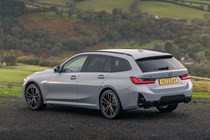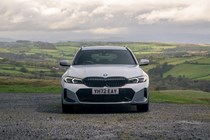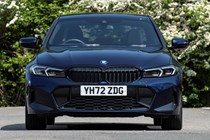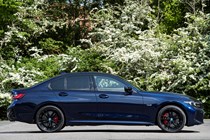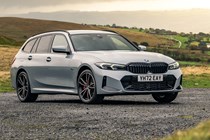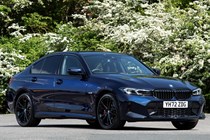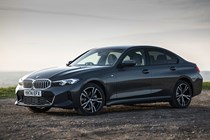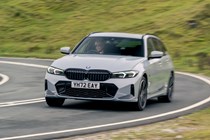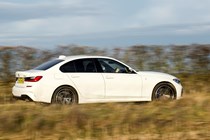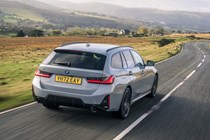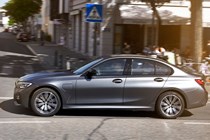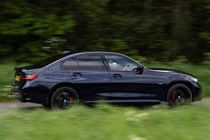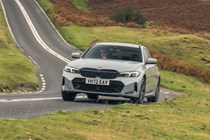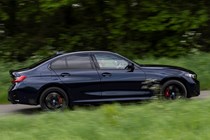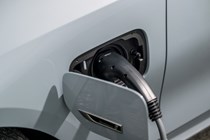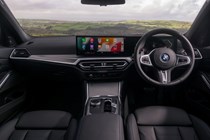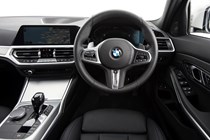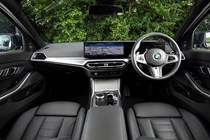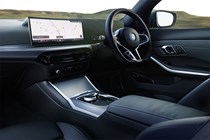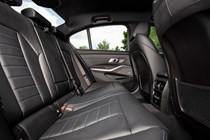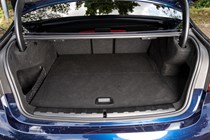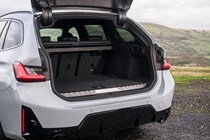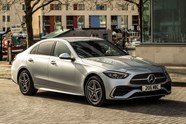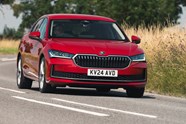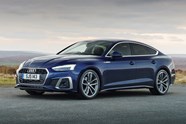
BMW 330e review
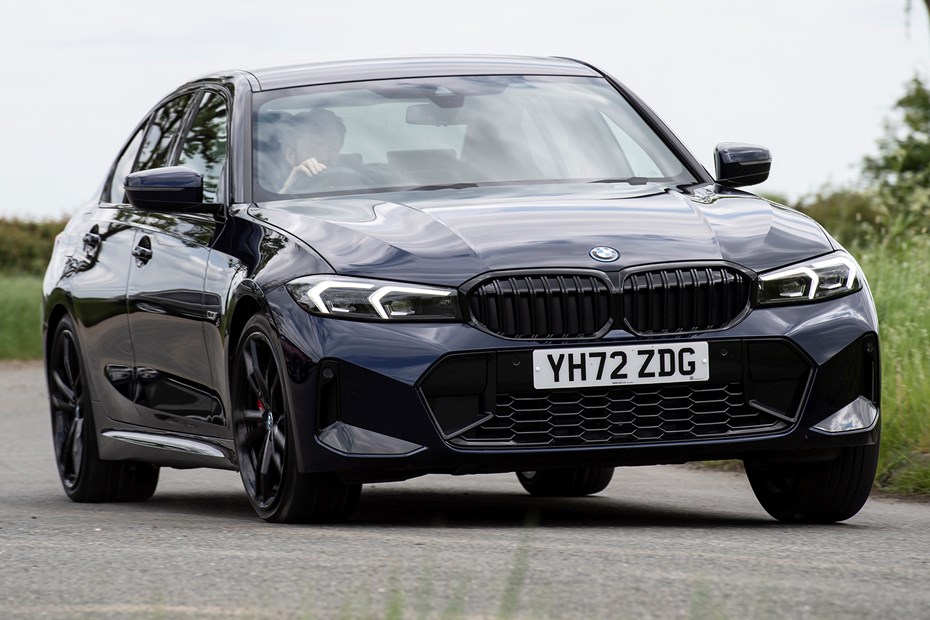
At a glance
| Price new | £47,095 - £54,595 |
|---|---|
| Used prices | £11,849 - £41,962 |
| Road tax cost | £195 - £620 |
| Insurance group | 33 - 36 |
Get an insurance quote with

|
|
| Fuel economy | 35.3 - 42.2 mpg |
| Miles per pound | 5.2 - 6.2 |
| Number of doors | 4 - 5 |
| View full specs for a specific version | |
Available fuel types
Hybrid
Pros & cons
- Up to 63 miles of electric range
- Precise steering and balanced handling
- Great efficiency and performance
- Not as good to drive as a standard 3 Series
- Reduced boot space compared with non plug-ins
- No longer available with four-wheel drive
BMW 330e Hybrid rivals
Overview
The regular 3 Series has been a stalwart of the aspirational middle managers since the 1980s – and since then, BMW has honed it into a mighty business tool we’ve no hesitation in calling our favourite choice in its class. The BMW 330e reviewed here brings the 3 Series right up to date as one of the very best hybrid cars on the market, aimed at drivers who want an plug-in hybrid car to reap the benefits of lower emissions, which ultimately means less company car tax to pay.
But what if you’re not a company car driver? Well we’re pleased to report the BMW 330e is a very good car, and not just a canny way to reduce a tax bill. Adding a battery and the ability to travel on pure electric power has taken very little of BMW’s driving prowess away from the 3 Series, while the interior is still one the most ergonomically designed on the market.
An update for the 2024 BMW 330e saw the electric range jump dramatically from 37 miles to 63 miles without sacrificing any more boot space alongside a new operating system for the infotainment and some tweaks to the interior to keep things fresh.
Direct rivals include PHEV (plug-in hybrid electric vehicle) variants of the Mercedes C-Class, Peugeot 508 and Skoda Superb. While indirect competitors are diverse, ranging from non plug-in estates and saloons such as the Audi A5 right up to electric SUVs including the Kia EV6 or Tesla Model Y. There’s also the all-electric BMW i4 to considered. We’ve driven the 330e extensively in the UK, and you can find out more about how we test on Parkers via our dedicated explainer page. Here’s what we found when we tested the car on some of the country’s most demanding roads.
What’s it like inside?
If you’re familiar with the standard BMW 3 Series, then you won’t find many surprises here. In fact, the only real thing to note is that boot space has been reduced. So you get a well-designed dashboard, hewn from robust materials that are also good to touch. It benefits from iDrive controls or touchscreen operation for the infotainment, while a small selection of buttons in the centre console handle the drive mode and charge management functions.

The saloon’s boot measures in at a pokey 375 litres compared to a regular 3 Series’ 480 litres. The fact the rear seats that don’t fold down doesn’t help matters either, boot space is the area this car falls down most. It’s the same story with the Touring (BMW’s term for an estate car) down 90 litres compared with the non-PHEV model for a total of 1,500 litres with the rear seats down. That compares with 1,510 litres for the Mercedes-Benz C300e Estate.
The size disparity is because the floor in the PHEV versions is higher than the non-battery versions in order to package the hybrid motors and power packs. That means you miss out on around two carry-on suitcases’ worth of space.
The infotainment system and digital dials are pretty much the same as the standard 3 Series, but they gain hybrid-related display options. However, aside from rearranging a few of the buttons on the centre console, this is the only difference in the passenger compartment when compared with the standard 3 Series interior.
This means that you get a massive infotainment screen running BMW Operating System 8.5, plus wireless Apple CarPlay and Android Auto as standard. This system works intuitively, until you need to change the heating. The specific temperature is nestled at the bottom of the screen, so it’s easy to adjust, but the fan speed and other controls are contained on a separate menu, which is irritating to use while driving. Most people will just end up using the (excellent) built-in voice control instead.
What’s it like to drive?
The 330e combines a 2.0-litre, four-cylinder turbo petrol engine with an electric motor that’s neatly integrated into the eight-speed automatic transmission. The petrol engine develops 184hp and the electric motor adds another 112hp. Very impressive, even if you can’t just add those two figures together to get the car’s total power output.
So, the 330e’s official power output is 252hp, which rises to 292hp when you activate the XtraBoost function for short periods of time under full acceleration. There’s no ‘push to pass’ boost button, it’s just activated by hoofing the accelerator in either the S or M transmission settings.
On the road, the results are impressive. Floor it from the lights and the 330e springs forward with real vigour. The 0-62mph time is 5.9 seconds, but it feels faster than that, especially considering how on the motorway it builds speed quicker than a diesel 330d. You only get 10 seconds of XtraBoost, but that’s more than enough on UK roads, because you’ll be into three figures if you floor the throttle in it from 30mph.
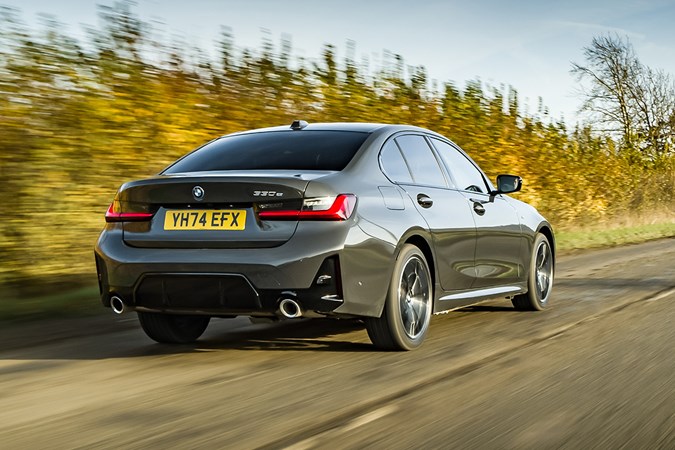
One criticism we’d level at the 330e is that it isn’t quite as enjoyable to drive as a regular 3 Series. The four-cylinder engine sounds strained when worked hard and the 330e feels less agile in bends, presumably as a result of accommodating the additional weight of the hybrid batteries. BMW has made an attempt to augment its sound in Sport mode, with a nod to older six-cylinder cars, but it doesn’t really convince on that score.
Another is that the automatic gearbox can be hesitant to change down gears, especially if you’re approaching a roundabout where you might need to slow down then speed up suddenly. A final gripe would be the lumpy ride quality on M Sport cars – so much so that in Sport drive mode, it’s so firm and bouncy that on a typically rough B-road it can become backache inducing.
But, leave it in Comfort, or buy the standard Sport version, and it’s still a car that devours bends without blinking, and in true BMW fashion, the harder you drive it, the better it gets. It’s just that a tiny little bit of the 3 Series magic has gone missing from the process, as exhibited by the slightly light and artificial feel to the steering (even in the heaviest Sport setting). Even so, you’ll enjoy driving it quickly more than you would a Mercedes C-Class plug-in although that car is a bit more comfortable.
What models and trims are available?
The 330e is available in Sport and M Sport specification. The former is the base model, but still comes with BMW’s sophisticated infotainment and cruise control. The latter adds larger 18-inch alloys and gives you the option to include BMW’s M Sport suspension which is lower and stiffer than the standard option.
Unfortunately, since 2024, you’re no longer been able to buy a 330e with four-wheel drive (called xDrive by BMW), with the choice being limited to rear-wheel drive only. For those looking to take the approved used approach to buying one, there’s very little difference between two- and four-wheel drive in day-to-day driving, but the XDrive model adds a bit of traction and extra reassurance in poor weather.
What else should I know?
The 330e is able to drive up to 63 miles on electric power alone, and there are an increased number of options to make the most of its battery. For example, you can set a guide percentage of power pack life you’d like to retain and the car will do its best to manage this on your behalf.
There is also an automatic setting, which works with the sat-nav guidance to choose the most appropriate points on your route to deploy the electricity. You can manually activate full electric mode up to 87mph and cruise there until the remaining range runs out.

As good as the range sounds, it’s worth remembering that newer rivals such as the Mercedes C-Class plug-in manages more than 63 miles on a single charge.
The official fuel economy for the 330e is a claimed a maximum of 353.1mpg in the WLTP real-world test, with CO2 emissions of just 25/km. You’ll need to be using the electric power a lot and mostly doing short journeys to get close to those figures, however.
You’ll also need to plug the hybrid part into the mains as many times as possible in between journeys – happily BMW now include an 11kW on-board charger to speed this up.
Is this still the best mid-sized company-focused plug-in hybrid you can buy? Our verdict on the BMW 330e can be found on the next page, where you can see whether we recommend the 3 Series PHEV over its younger rivals.



